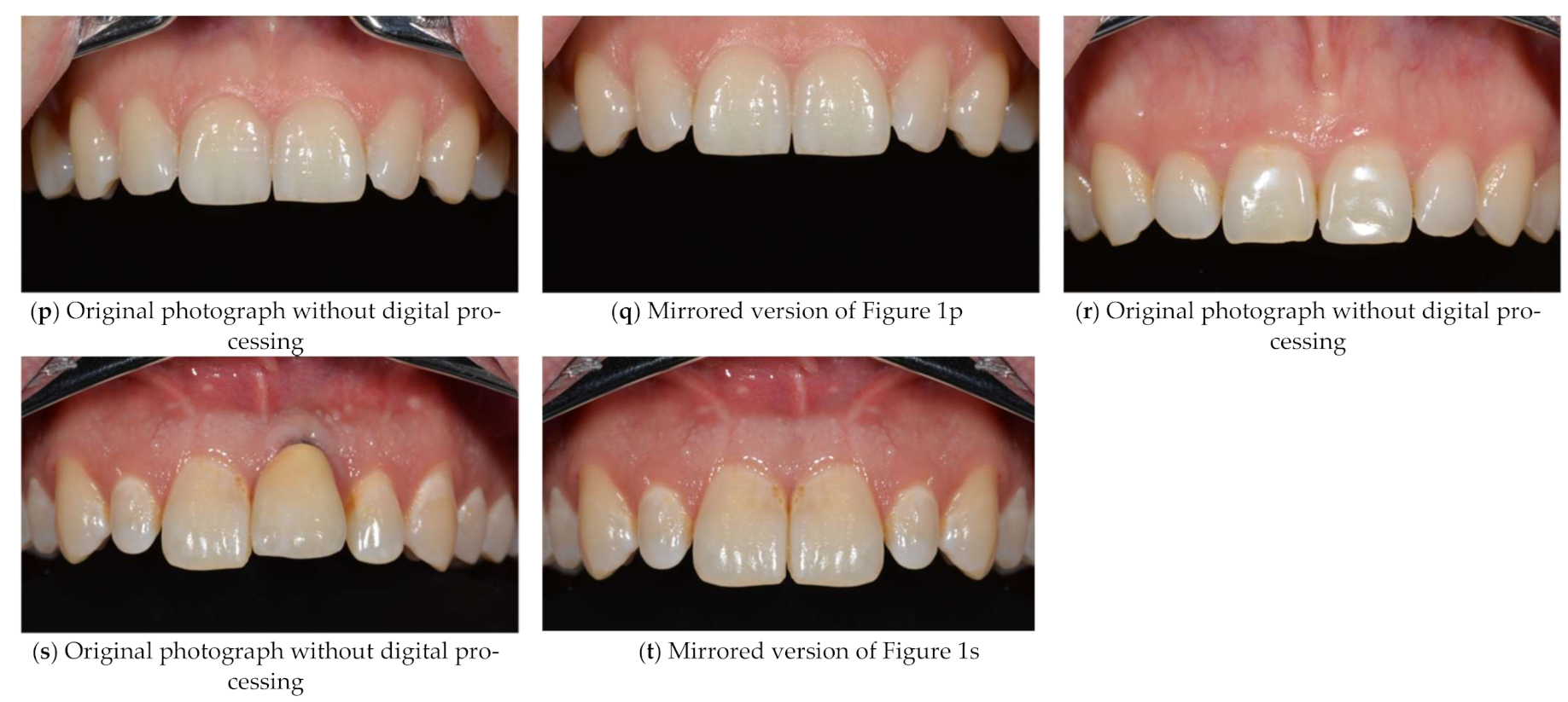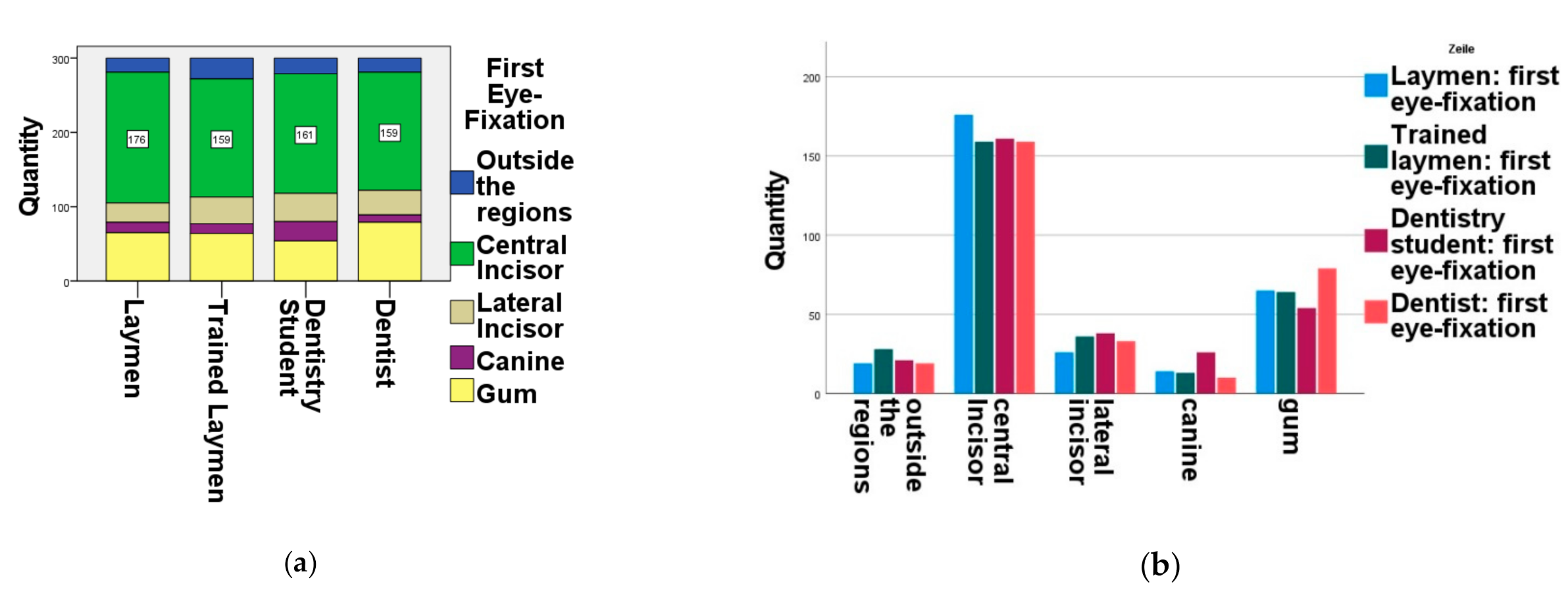Influencing Factors on Aesthetics: Highly Controlled Study Based on Eye Movement and the Forensic Aspects in Computer-Based Assessment of Visual Appeal in Upper Front Teeth
Abstract
:1. Introduction
2. Materials and Methods
2.1. Subject Group
2.2. Design
2.3. Statistical Analysis
3. Results
3.1. Descriptive Analysis
3.2. Ordinal Regression
4. Discussion
5. Conclusions
Author Contributions
Funding
Institutional Review Board Statement
Informed Consent Statement
Data Availability Statement
Conflicts of Interest
References
- Machado, A.W.; Moon, W.; Gandini, L.G., Jr. Influence of maxillary incisor edge asymmetries on the perception of smile esthetics among orthodontists and laypersons. Am. J. Orthod. Dentofac. Orthop. 2013, 143, 658–664. [Google Scholar] [CrossRef] [Green Version]
- Borda, A.F.; Garfinkle, J.S.; Covell, D.A.; Wang, M.; Doyle, L.; Sedgley, C.M. Outcome assessment of orthodontic clear aligner vs fixed appliance treatment in a teenage population with mild malocclusions. Angle Orthod. 2020, 90, 485–490. [Google Scholar] [CrossRef]
- Hennessy, J.; Al-Awadhi, E.A. Clear aligners generations and orthodontic tooth movement. J. Orthod. 2016, 43, 68–76. [Google Scholar] [CrossRef]
- Gu, J.; Tang, J.S.; Skulski, B.; Fields, H.W., Jr.; Beck, F.M.; Firestone, A.R.; Kim, D.-G.; Deguchi, T. Evaluation of Invisalign treatment effectiveness and efficiency compared with conventional fixed appliances using the Peer Assessment Rating index. Am. J. Orthod. Dentofac. Orthop. 2017, 151, 259–266. [Google Scholar] [CrossRef]
- Machado, A.W. 10 commandments of smile esthetics. Dent. Press J. Orthod. 2014, 19, 136–157. [Google Scholar] [CrossRef] [Green Version]
- Liao, P.; Fan, Y.; Nathanson, D. Evaluation of maxillary anterior teeth width: A systematic review. J. Prosthet. Dent. 2019, 122, 275–281.e7. [Google Scholar] [CrossRef] [PubMed]
- Monnet-Corti, V.; Antezack, A.; Pignoly, M. Perfecting smile esthetics: Keep it pink! Orthod. Fr. 2018, 89, 71–80. [Google Scholar] [CrossRef]
- Khalid, A.; Quiñonez, C. Straight, white teeth as a social prerogative. Sociol. Health Illn. 2015, 37, 782–796. [Google Scholar] [CrossRef] [PubMed]
- Daneshvar, M.; Devji, T.F.; Davis, A.B.; White, M.A. Oral health related quality of life: A novel metric targeted to young adults. J. Public Health Dent. 2015, 75, 298–307. [Google Scholar] [CrossRef]
- Theobald, A.H.; Wong, B.K.J.; Quick, A.N.; Thomson, W.M. The impact of the popular media on cosmetic dentistry. N. Z. Dent. J. 2006, 102, 58–63. [Google Scholar] [PubMed]
- Pithon, M.M.; Nascimento, C.C.; Barbosa, G.C.G.; Coqueiro, R.D.S. Do dental esthetics have any influence on finding a job? Am. J. Orthod. Dentofac. Orthop. 2014, 146, 423–429. [Google Scholar] [CrossRef]
- Malkinson, S.; Waldrop, T.C.; Gunsolley, J.C.; Lanning, S.K.; Sabatini, R. The effect of esthetic crown lengthening on perceptions of a patient’s attractiveness, friendliness, trustworthiness, intelligence, and self-confidence. J. Periodontol. 2013, 84, 1126–1133. [Google Scholar] [CrossRef] [Green Version]
- Correa, B.D.; Bittencourt, M.A.V.; Machado, A.W. Influence of maxillary canine gingival margin asymmetries on the perception of smile esthetics among orthodontists and laypersons. Am. J. Orthod. Dentofac. Orthop. 2014, 145, 55–63. [Google Scholar] [CrossRef] [PubMed]
- Holden, A.C.L. Consumed by prestige: The mouth, consumerism and the dental profession. Med. Health Care Philos. 2019, 23, 261–268. [Google Scholar] [CrossRef] [PubMed]
- Kleinberger, J.A.; Strickhouser, S.M. Missing Teeth: Reviewing the Sociology of Oral Health and Healthcare. Sociol. Compass 2014, 8, 1296–1314. [Google Scholar] [CrossRef]
- Parrini, S.; Rossini, G.; Castroflorio, T.; Fortini, A.; Deregibus, A.; Debernardi, C. Laypeople’s perceptions of frontal smile esthetics: A systematic review. Am. J. Orthod. Dentofac. Orthop. 2016, 150, 740–750. [Google Scholar] [CrossRef]
- Brough, E.; Donaldson, A.N.; Naini, F.B. Canine substitution for missing maxillary lateral incisors: The influence of canine mor-phology, size, and shade on perceptions of smile attractiveness. Am. J. Orthod. Dentofac. Orthop. 2010, 138, 705.e1–705.e9, discussion-7. [Google Scholar] [CrossRef]
- Thomas, M.; Reddy, R.; Reddy, B.J. Perception differences of altered dental esthetics by dental professionals and laypersons. Indian J. Dent. Res. 2011, 22, 242–247. [Google Scholar] [CrossRef]
- Ma, W.; Preston, B.; Asai, Y.; Guan, H.; Guan, G. Perceptions of dental professionals and laypeople to altered maxillary incisor crowding. Am. J. Orthod. Dentofac. Orthop. 2014, 146, 579–586. [Google Scholar] [CrossRef]
- Kaya, B.; Uyar, R. Influence on smile attractiveness of the smile arc in conjunction with gingival display. Am. J. Orthod. Dentofac. Orthop. 2013, 144, 541–547. [Google Scholar] [CrossRef]
- Sarver, D.; Jacobson, R.S. The Aesthetic Dentofacial Analysis. Clin. Plast. Surg. 2007, 34, 369–394. [Google Scholar] [CrossRef] [PubMed]
- Richards, M.R.; Fields, H.W., Jr.; Beck, F.M.; Firestone, A.R.; Walther, D.B.; Rosenstiel, S.; Sacksteder, J.M. Contribution of malocclusion and female facial attractiveness to smile esthetics evaluated by eye tracking. Am. J. Orthod. Dentofac. Orthop. 2015, 147, 472–482. [Google Scholar] [CrossRef] [Green Version]
- Baker, R.S.; Fields, H.W., Jr.; Beck, F.M.; Firestone, A.R.; Rosenstiel, S.F. Objective assessment of the contribution of dental esthetics and facial attractiveness in men via eye tracking. Am. J. Orthod. Dentofac. Orthop. 2018, 153, 523–533. [Google Scholar] [CrossRef] [Green Version]
- Yamamoto, M.; Torii, K.; Sato, M.; Tanaka, J.; Tanaka, M. Analysis of gaze points for mouth images using an eye tracking system. J. Prosthodont. Res. 2017, 61, 379–386. [Google Scholar] [CrossRef]
- Suwa, K.; Furukawa, A.; Matsumoto, T.; Yosue, T. Analyzing the eye movement of dentists during their reading of CT images. Odontol. 2001, 89, 54–61. [Google Scholar] [CrossRef] [PubMed]
- Del Monte, S.; Afrashtehfar, K.I.; Emami, E.; Abi Nader, S.; Tamimi, F. Lay preferences for dentogingival esthetic parameters: A systematic review. J. Prosthet. Dent. 2017, 118, 717–724. [Google Scholar] [CrossRef] [PubMed]
- Joiner, A.; Luo, W. Tooth colour and whiteness: A review. J. Dent. 2017, 67, S3–S10. [Google Scholar] [CrossRef]





| Correlations | |||||||
|---|---|---|---|---|---|---|---|
| Rating | Gender | Status | Age | First_Eyefixation | |||
| Kendall-Tau-b | Rating | Correlation coefficient | 1000 | −0.006 | 0.013 | * −0.069 | * −0.069 |
| Sig. (two-sided) | - | 0.815 | 0.57 | 0.003 | 0.003 | ||
| N | 1200 | 1200 | 1200 | 1200 | 1200 | ||
| Gender | Correlation coefficient | −0.006 | 1000 | * 0.226 | * 0.212 | 0.023 | |
| Sig. (two-sided) | 0.815 | - | <0.001 | <0.001 | 0.391 | ||
| N | 1200 | 1200 | 1200 | 1200 | 1200 | ||
| Status | Correlation coefficient | 0.013 | * 0.226 | 1000 | * −0.27 | 0.033 | |
| Sig. (two-sided) | 0.57 | <0.001 | - | <0.001 | 0.173 | ||
| N | 1200 | 1200 | 1200 | 1200 | 1200 | ||
| Age | Correlation coefficient | * −0.069 | * 0.212 | * −0.27 | 1000 | −0.028 | |
| Sig. (two-sided) | 0.003 | <0.001 | <0.001 | - | 0.266 | ||
| N | 1200 | 1200 | 1200 | 1200 | 1200 | ||
| First_Eyefixation | Correlation coefficient | * −0.069 | 0.023 | 0.033 | −0.028 | 1000 | |
| Sig. (two-sided) | 0.003 | 0.391 | 0.173 | 0.266 | - | ||
| N | 1200 | 1200 | 1200 | 1200 | 1200 | ||
| Non-Standardized Coefficients | Standardized Coefficients | 95.0% Confidence Intervals for B | |||||
|---|---|---|---|---|---|---|---|
| Reg. Coefficient B | Std.-Mistake | Beta | T | Sig. | Lower Limit | Upper Limit | |
| Constant | 1.875 | 0.172 | - | 10.874 | <0.001 | 1.537 | 2.213 |
| Gender | 0.117 | 0.085 | 0.043 | 1.379 | 0.168 | −0.05 | 0.284 |
| Status | −0.013 | 0.041 | −0.011 | −0.302 | 0.763 | −0.094 | 0.069 |
| Age | −0.067 | 0.031 | −0.075 | −2.176 | 0.03 | −0.128 | −0.007 |
Publisher’s Note: MDPI stays neutral with regard to jurisdictional claims in published maps and institutional affiliations. |
© 2021 by the authors. Licensee MDPI, Basel, Switzerland. This article is an open access article distributed under the terms and conditions of the Creative Commons Attribution (CC BY) license (https://creativecommons.org/licenses/by/4.0/).
Share and Cite
Bjelopavlovic, M.; Weyhrauch, M.; Erbe, C.; Burkard, F.; Petrowski, K.; Lehmann, K.M. Influencing Factors on Aesthetics: Highly Controlled Study Based on Eye Movement and the Forensic Aspects in Computer-Based Assessment of Visual Appeal in Upper Front Teeth. Appl. Sci. 2021, 11, 6797. https://doi.org/10.3390/app11156797
Bjelopavlovic M, Weyhrauch M, Erbe C, Burkard F, Petrowski K, Lehmann KM. Influencing Factors on Aesthetics: Highly Controlled Study Based on Eye Movement and the Forensic Aspects in Computer-Based Assessment of Visual Appeal in Upper Front Teeth. Applied Sciences. 2021; 11(15):6797. https://doi.org/10.3390/app11156797
Chicago/Turabian StyleBjelopavlovic, Monika, Michael Weyhrauch, Christina Erbe, Franziska Burkard, Katja Petrowski, and Karl Martin Lehmann. 2021. "Influencing Factors on Aesthetics: Highly Controlled Study Based on Eye Movement and the Forensic Aspects in Computer-Based Assessment of Visual Appeal in Upper Front Teeth" Applied Sciences 11, no. 15: 6797. https://doi.org/10.3390/app11156797
APA StyleBjelopavlovic, M., Weyhrauch, M., Erbe, C., Burkard, F., Petrowski, K., & Lehmann, K. M. (2021). Influencing Factors on Aesthetics: Highly Controlled Study Based on Eye Movement and the Forensic Aspects in Computer-Based Assessment of Visual Appeal in Upper Front Teeth. Applied Sciences, 11(15), 6797. https://doi.org/10.3390/app11156797






